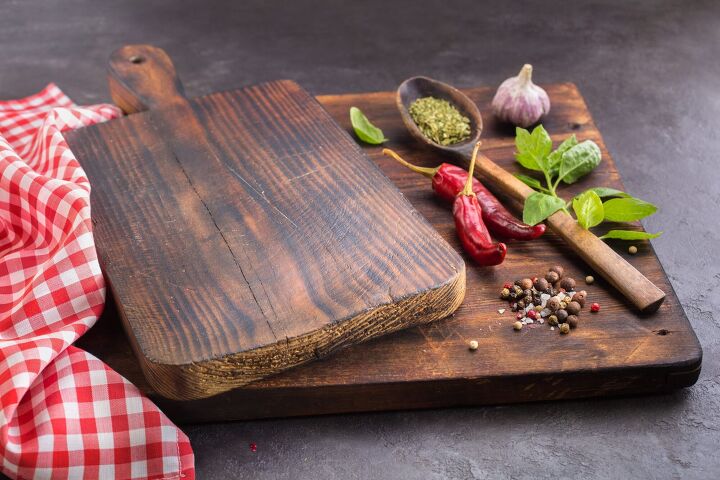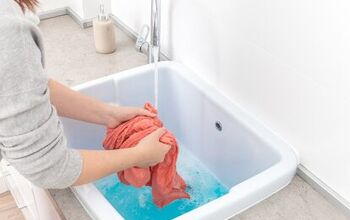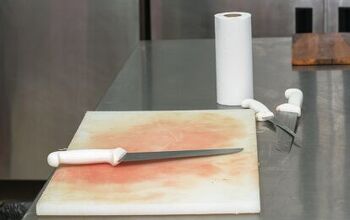What Is The Best Type Of Wood Cutting Board?

Cutting boards are the most commonly used item in every kitchen. They come in all shapes and sizes. They are made out of every imaginable material, from plastic to glass, but the classic cutting material has always been wood.
Nothing beats the look of a sturdy well-crafted wooden cutting board. But even among wooden cutting boards, there is so much variation and a plethora of wood types to choose from. But of all the choices out there, which types of wooden cutting boards are the best?
When selecting a wooden cutting board you should choose a wood that is hard but not too hard. Also, look for wood that repel water and are not porous. Some of the best wood for cutting boards include acacia, maple, walnut, beech, and cherry. When you select a wooden cutting board, consider the maintenance involved, the cost, and even its environmental impact.
If you are in the market for a new wooden cutting board, you have likely found that your options are almost endless. There are tons of brands, aesthetics, cutting board sizes, and wood types to choose from. But make sure you don’t just choose a board based on what is cheapest or what looks the cutest. Read further to learn about the types of wood that are best, and the factors you should consider when shopping for the perfect wooden cutting board.
Top Five Wood Types For A Cutting Board
1. Acacia
Acacia wood is a very popular and quality wood for cutting boards. It also tends to be fairly affordable. Acacia wood is not porous, it has an attractive look, but what really makes this wood great for cutting boards is its durability. Acacia wood cutting boards are a good choice because they hold up to lots of wear and tear, which is an ideal trait to have in a cutting board.
2. Maple
Maple is a popular wood for the home that is considered by many to be the industry standard, or “pinnacle” of all wood cutting boards. The main reason for this is because it is a very firm wood but has a little bit of give. This means its sturdy nature protects against warping and damage and it is easy to wash and clean. It also provides enough give for sharp knives so they do not dull prematurely.
3. Walnut
Walnut is another strong wood that makes a great cutting board. Walnut wood can be expensive, but it is hardwood and has a rich color that looks good in any kitchen. The oils found in this wood are also effective at healing the cutting board. Small scratches and dings made by knives are smoothed over thanks to this wood’s almost magical self-healing properties.
4. Beech
Beech wood might not be as popular as maple and acacia when it comes to cutting boards, but it is still a fantastic choice when selecting the best wood cutting board. This is because in addition to being a strong wood, it has a very small porous surface. This makes it one of the more sanitary wood options. Beech wood is also stunning in appearance. It is a blonde wood, but it has a very dark grain, which provides a really nice contrast and an interesting natural appearance.
5. Cherry
Cherry wood is another type with all the attributes of a perfect wooden cutting board. Like maple, it is a very hard wood, but not so hard that it will dull a knife. It is also has a small-porous surface. Being a fruit tree, it is a toxin-free wood, making its surfaces naturally safe for your food. It also has a lovely and regal color.
Five Factors To Consider When Choosing A Wooden Cutting Board
Firm Vs. Soft Wood
One of the top qualities you need to pay attention to when selecting the best wood type for your cutting board is the wood’s firmness. Your logic might tell you that the harder the wood the better. This is true to an extent, but believe it or not, the hardest woods are not the most ideal. Wood that is too hard can damage and dull knives faster than necessary. These woods also tend to be very expensive.
Instead, it is ideal to choose woods that are strong and firm, but not too firm. Softer woods are not ideal as they won’t hold up to the constant cutting and abuse a cutting board is likely to take over time.
Level Of Required Mainteance
Another factor to consider is the maintenance the wood you select requires. Some wood needs to be oiled or air dried. Others require immediate washing, while others don’t love washing, especially with soap. Be sure whatever wood type you select has a maintenance schedule you are comfortable with.
Environmental Sustainability
It is becoming increasingly clear that making environmentally conscious purchases is important to the future of the planet. This is particularly true with products made of natural materials such as wood. Wood like maple has been harvested in the US for decades, and these trees regenerate quickly. But other species are not as easy to replenish. Therefore, look for an environmentally efficient seal or pledge when shopping for a cutting board. This way you know you are not depleting trees in your hunt for the perfect board.
Repelling Water And Porousness
A wood’s ability to absorb or repel moisture is another huge variable that requires some thought when deciding on a cutting board. Wood that naturally repels water is ideal, as you will have to wash your cutting board often. Wood that absorbs water are likely to warp easier, and even grow mold.
A porous wood is also harder to clean. If it absorbs water, it can also absorb and hold onto bacteria, which is the last thing you want on your cutting board.
The Price Tag
You also need to think about the price. While it would be great to have a huge solid maple or cherry wood butcher block, that can cost you hundreds of dollars. Make sure you consider the wood and the price. Acacia wood and some maple products are usually a bit more affordable than cherry or teak. Just shop around, as there are tons of choices.
Why A Quality Wood Cutting Board Is Important
- Keeps Knives Sharp: A quality cutting board will keep your knives sharp. Wood is great because it has a very slight give to it. Other materials, like glass and hard plastic, are bound to dull your knives prematurely.
- Keeps Germs At Bay: A well-made and properly treated cutting board should help repel germs, and be easy to clean.
- Looks As Good As It Performs:
- Built To Last
Woods That Do Not Make Good Cutting Boards
There are many wood types that make great cutting boards. But there is also some types of woods that might make great furniture and other products but are not the best choice for a cutting board. Some wood is too hard, others are too soft, and some are too porous. Below is a list of a wood types that are popular but not ideal to use as a cutting board. Keep in mind you can still purchase cutting boards made of these kinds of wood, and they might make for great serving trays, but they are less ideal than the wood we mentioned above.
- Mahogany
- Rosewood
- Pine
- Cedar
Concluding Notes On What Type Of Wood Cutting Board Is Best
A wooden cutting board is a staple for every kitchen. It looks great and often performs better than plastic, glass, and other types of cutting boards. While wooden cutting boards can be made from nearly any type of wood, some types of wood are better than others. The best wood to use for a cutting board includes acacia, maple, cherry, beech, and walnut. Make sure the wood you use does not have a negative impact on the environment and also be aware of the maintenance schedule of the board before you purchase it.
Related Guides:

Tom Gaffey is an expert writer who currently resides in Washington D.C. Tom has a passion for real estate and home improvement writing, as well as travel and lifestyle writing. He lived the last twelve years in Hawaii where he worked closely with luxury resorts and event planners, mastering his knowledge of aesthetics and luxury products. This is where he found his passion for home improvement and a keen interest in DIY projects. Currently, Tom resides in Washington D.C, and also working on his debut fiction novel.
More by Tom Gaffey


















![12 Washing Machine Brands to Avoid [with Recall Data]](https://cdn-fastly.upgradedhome.com/media/2023/07/31/9075781/12-washing-machine-brands-to-avoid-with-recall-data.jpg?size=350x220)








